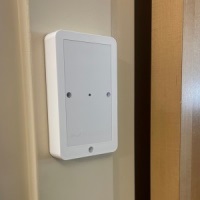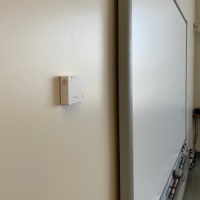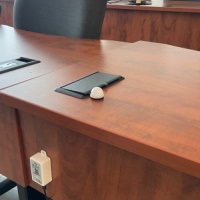Increasing Campus Accessibility for the Neurodiverse Student Population at NBCC
Research Area: Health | Status: Ongoing | Led By: Researcher-led
Have you seen these devices in classrooms, common areas, or hallways and wondered what they are?
The devices you see in these pictures of the NBCC Fredericton campus are sensors capable of measuring light levels, sound levels, and the number of people entering and leaving a classroom.
We understand one of the first concerns you may have when learning these devices are measuring light and sound is your right to privacy. We take such concerns seriously, and that is why the current project has undergone a Research Ethics Board review to ensure your rights to privacy are not being violated. Moreover, we wish to stress that the sensors are only collecting information about overall light levels (measured in lumens), and noise levels (measured in decibels). These sensors do not have the capacity to record video or conversations.
Why are these sensors being placed throughout the Fredericton campus?
The sensors placed throughout the campus are part of an ongoing project aimed at increasing campus accessibility for the neurodiverse student body. Colleges and universities have made significant progress towards making their campuses more accessible for underrepresented groups over the past few years. For example, students with mobility difficulties will find most campuses are now equipped with quality-of-life improvements such as ramps, elevators, electronic doors, and wheelchair-accessible bathrooms.
While this progress should be lauded, it is important to recognize that other disenfranchised groups have not experienced similar levels of accessibility enhancements on campuses. Neurodiverse individuals in particular may experience high levels of discomfort when entering and navigating campuses due to the type of lighting used, brightness levels, noise levels, traffic levels between classrooms, and fragrances/scents limiting their ability to remain on campus. Therefore, the purpose of the current project is to use sensors to measure overall brightness levels (lumens), noise levels (decibels), and student traffic on the campus.
Our project partner will input this information into their proprietary software to create a digital “twin” of the campus. Students will then be able to access this digital “twin” to see which areas of the campus are so bright or loud that they could cause discomfort. Students can then use this knowledge to avoid certain areas of the campus if they so wish.
College administration can also use this knowledge to work with Facilities and other units to make the campus more accessible. This current project is part of a pilot project, and if this proves successful a larger-scale project collecting other sensory information (ex. Olfactory information) will be conducted.
We thank you for your cooperation during this time!
Questions?
Feel free to contact Dr. Kyle Brymer, Research Associate in Health, kyle.brymer@nbcc.ca
Collaborate with us!
Email appliedresearch@nbcc.ca to learn more about how NBCC students can help you reach your business goals.
About Applied Research and Innovation
NBCC’s Applied Research and Innovation office helps businesses and communities find solutions to their challenges. Through its expertise, equipment, and facilities, NBCC helps its partners to solve problems, take advantage of market opportunities, and develop new, innovative processes that will enhance how New Brunswickers live, work and do business.




